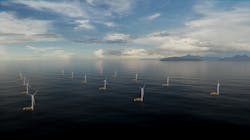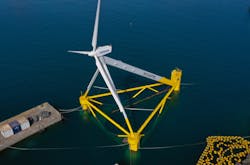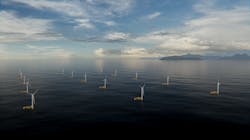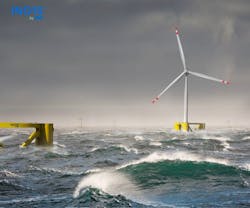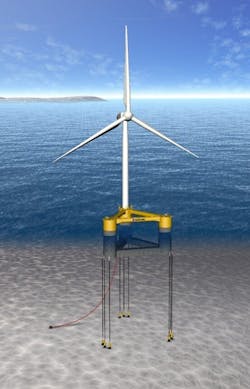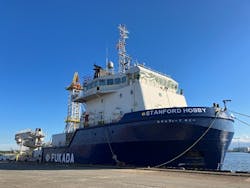Floating offshore wind projects sprouting up worldwide
Editor's note: This story first appeared in the September-October 2022 issue of Offshore magazine's first annual Offshore Wind Special Report. Click here to view the full Offshore issue or click here to view the special report.
By Jeremy Beckman, Editor, Europe
Global concerns over energy security have added impetus to offshore wind expansion initiatives this year, with greater urgency to extend activity to locations farther out at sea. Technology developers are responding by advancing studies and testing for new concepts, many targeting the floating offshore wind sector. These developments are attracting increasing support from investors and governments, with prototype and commercial floating wind projects starting to proliferate across the North Sea, eastern Atlantic and Mediterranean Sea, and extending to Southeast Asia and Australia, with emerging interest too on the US eastern seaboard.
UK region staying busy
Equinor has led the way in the North Sea with its relatively small-scale Hywind Scotland floating wind project off the Scottish east coast in the late 2010s, and the company is now close to powering up Hywind Tampen, the world’s first floating wind development dedicated to electrification of offshore platforms, in this case at the Gullfaks and Snorre fields. Most new, and many existing, Norwegian oil and gas projects receive power from shore, imported via long-distance subsea cables from hydropower plants in western Norway. But there are limits to these hydropower resources, as underlined by this summer’s prolonged drought across Europe; the proposed Trollvind floating offshore wind farm 65 km west of Bergen would partly address this issue. The complex, planned by Equinor and its partners Petoro, TotalEnergies, Shell and ConocoPhillips in the Troll and Oseberg fields, would be constructed in the Troll area, with an installed capacity of about ~1 GW and an annual production of ~4.3 TWh, with a potential startup in 2027. Aside from supplying much of the electricity needed to run the Troll and Oseberg facilities, surplus power could be delivered to the Bergen region.
Earlier this year, Norway’s government announced plans for the country’s first floating offshore wind auction, covering 1.5 GW in the Utsira Nord lease area of the Norwegian North Sea. The terms have since been changed, with awards to be issued based on qualitative criteria that support innovation and technology development.
In the UK, a consortium between Ørsted, Falck Renewables and BlueFloat Energy has signed an option agreement with Crown Estate Scotland for a new floating offshore wind site of up to 1 GW off Scotland’s northeast coast, awarded under the recent ScotWind offshore wind leasing round. The planned development will be located 50 km east of Wick and will be Ørsted’s first large-scale floating wind project.
Cerulean Winds, one of the UK’s leading advocates of floating offshore wind linked to green hydrogen, aims to develop three 1-GW floating wind projects at locations west of Shetland and in the UK central North Sea to support decarbonization of oil and gas operations in these areas. Under a memorandum of understanding announced last April, Lamprell would provide fabrication, assembly and outfitting of the NOV-designed tri-floaters, featuring steel floater bases that could be floated offshore (unlike alternative cement floating wind structures). In January this year, Cerulean Winds also secured funding from the UK’s department for Business, Energy & Industrial Strategy to develop an integrated system between the mooring, floating foundation and wind turbine for deployment at an offshore oil and gas facility in the North Sea or west of Shetland.
The company intended to bid for seabed lease sites offered under Crown Estate Scotland’s current Innovation and Targeted Oil and Gas leasing round (INTOG), which includes four 1.5-GW sites for floating wind power. The round is designed specifically for small-scale, innovative offshore wind projects that will directly reduce emissions from offshore oil and gas production and help boost further innovation. Recently, Crown Estate Scotland named the joint venture (JV) between Mainstream Renewable Power and Ocean Winds as preferred bidder for an area east of the Shetland Islands in 100 m water depth, said to be suitable for floating offshore wind. The two companies have pledged to develop floating offshore wind on an industrial scale in Scotland. Additionally, the UK Crown Estate plans to issue a competitive tender next year for areas in the Celtic Sea off western Britain suitable for floating offshore wind energy generation combined with green hydrogen production.
Companies that have publicly expressed interest include Source Energie, which aims to deploy its Dolphyn technology to produce large-scale low-carbon green hydrogen from floating offshore wind in the Celtic Sea, with the hydrogen exported to shore via a pipeline. Dolphyn would be used to develop the 300-MW Dylan wind farm by 2028, expanding to gigawatt scale in the 2030s. Elsewhere in the Celtic Sea, Blue Gem Wind, the JV between TotalEnergies and Simply Blue Group, is progressing pre-FEED for the Valorous floating wind project, 50 km offshore southwest Wales. It follows Erebus, a 100-MW test and demonstration project and the first planned floating offshore wind project in the region. Principle Power Inc., developer of the Windfloat technology, will provide the floating platforms and project support.
Mediterranean Sea projects ramping up
France, which had been one of the slower countries in western Europe to take up offshore wind, now has various fixed-bottom shallow-water wind power projects moving close to completion off its north and west coasts.
Earlier this year SBM Offshore launched Float4Wind, a new and simpler version of its tension leg platform (TLP) design, which the company says is suited to larger capacity wind turbines, deeper water settings and harsher sea conditions.
Work should have started on NextFloat, a project recently approved for financial support from the European Commission, under a consortium between Technip Energies, Barcelona-based X1 Wind and various European technical institutes and specialist technology developers, and Tersan Shipyard. The project is designed to demonstrate a competitive, integrated floating offshore wind solution suited to deepwater and can accelerate industrial-scale deployment of floating offshore wind for developments of more than 15 MW. It will include the deployment of a full-scale 6-MW prototype and installation procedures at the Mistral test site in the French Mediterranean Sea. The concept, based on X1 Wind floating offshore wind technology, is targeting a lighter floater design, a reduced steel requirement and a more compact, efficient mooring system.
In recent years, X1 Wind has progressed its technology, which it first developed in 2012, and it completed the design, assembly and load-out of a full-featured part-scale demonstrator for its floating wind PivotBuoy prototype at the PLOCAN test site in the Canary Islands. PivotBuoy aims to substantially reduce the current levelized cost of electricity of floating wind. Advantages of the PivotBuoy system are said to include a reduced floater weight, faster and cheaper installation processes, and suitability for deeper waters with a minimal seabed footprint due to the TLP mooring system.
Last May, production started for the Qair-operated 30-MW Eolmed wind farm project, in which TotalEnergies has a 20% stake. The three 10-MW wind turbines, mounted on steel floats, will be located more than 18 km from the coast of Gruissan and Port la Nouvelle in France’s Occitan region, and they will export power to the French Electricity Transmission Network (RTE) via an undersea cable. Production is due to start in 2024. TotalEnergies is also in a consortium with Corio Generation and Qair that was pre-selected earlier this year by the French Directorate General for Energy and Climate to participate in a tender to develop two floating windfarms, each of almost 250 MW, in the Golfe du Lion in the Mediterranean Sea.
Renexia recently contracted Fugro to perform geophysical and environmental surveys over the site for its proposed 850-sq-km Med Wind floating wind farm 60 km offshore in the Strait of Sicily, southern Italy, which the company is looking to bring onstream in early 2026. This will be one of the largest offshore wind projects in the Mediterranean Sea, with 190 floating turbines providing an installed capacity of 2.8 GW, in water depths ranging from 300 m to 900 m.
Another semisubmersible platform concept for floating wind is INO12, under development by Inocean, a Norwegian subsidiary of Technip. This is designed to accommodate a 12-MW wind turbine, with a life span of 25 years without dry docking. The concept has been selected for further study under the four-year WINDMOOR project (Advanced Wave and Wind Load Models for Floating Wind Turbine Mooring System Design), funded by the Research Council of Norway and offshore wind industry. The main aim is to achieve a more efficient design of floating wind turbine farms, improving load analysis methods by developing validated hydrodynamic load models for low-frequency excitation and damping of the turbines; and achieving a better understanding of the consequences of atmospheric stability and aerodynamic interactions between turbines for floating wind turbine dynamics.
East Asia innovations
Across the eastern hemisphere in Southeast Asia, a 50:50 partnership between TotalEnergies and Macquarie’s Green Investment Group plans to develop five floating offshore wind projects in South Korea with a potential combined capacity of more than 2 GW, at locations off the eastern and southern coasts in Ulsan and South Jeolla Provinces. The co-venturers aim to initiate construction of the 500-MW Bada project by year-end 2023.
California-based Principal Power Inc. said earlier this year that it was seeking feedback from developers and contractors on its next-generation WindFloat design, which it said is ready to support the 15-MW to 20-MW wind turbines for future floating wind projects in Korea and Scotland. Its recent focus has been on addressing bottlenecks in the fabrication, assembly, loadout and installation phases to simplify the entire delivery system and reduce costs. This in turn should help new floating wind projects become subsidy-free. The WindFloat is a permanently moored semisubmersible, three-column stabilized floating platform for offshore wind turbines, with performance-enhancing features such as damping plates and a smart hull trim system.
In South Korea, the company has partnered with Wind Power Korea to drive forward the 1,000-MW Korea Floating Wind (KFWind) project in 250 m of water, 65 km from the coast of Ulsan in the East Sea, and which will employ the WindFloat technology. In 2019 Ocean Winds and Aker Offshore Wind bought a majority interest in the project, which will comprise 60 to 100 wind turbines, with first power expected in 2026. Principle Power has since opened an office in Japan, seeking deepwater opportunities there. One of its partners in the country recently received a grant under the government’s recently launched Green Innovation Fund, which targets different innovations in renewable energy technology. Principal Power sees strong potential for local technological support for offshore wind in areas such as power cables and digital solutions, noting that the major wind turbine manufacturers are also forming partnerships with major Japanese companies.
In Singapore, Sembcorp Marine, which is looking to merge with Keppel, has a joint research project with the Technology Centre for Offshore and Marine to further develop, validate, test and improve the SWACH (Small Waterplane Area Cylindrical Hull) design created by Semcorp subsidiary Sevan SSP. This is said to be a cost-efficient floating foundation solution that could house the world’s largest wind turbines, providing good motion characteristics in harsh conditions and suited to modularized fabrication and assembly. The shallow draft allows the unit to be fully assembled onshore with a wet tow to final location. Another Sembcorp development is the Semi-submersible Integrating Vertical Adjustable Mast (SI-VAM) wind solution, which has received approval in principle from DNV.
Madrid-based developer BlueFloat Energy is working on September Winds, a floating offshore wind development in Taiwan, 25 km from the coast of Hsinchu County and Hsinchu City in 70-m to 80-m water depths. The project, named after the strong winds that always blow in the Hsinchu region during September, has a planned capacity of more than 1 GW. Additionally, in a newly identified offshore wind renewable energy zone off New South Wales, Australia, BlueFloat plans to install 3.6 MW of floating offshore wind capacity at the Hunter Coast and Wollongong developments.
US research initiatives
Finally, on the east coast US, the state of Maine has applied to the Bureau of Ocean Energy Management (BOEM) to set aside 9,700 acres on the Outer Continental Shelf, more than 20 nautical miles off its coast. This would house a research array comprising up to 12 floating offshore wind turbines capable of generating up to 144 MW of renewable energy. The Request for Competitive Interest area of 68,320 acres issued by BOEM expands upon Maine’s requested research lease area, allowing for future siting flexibility to avoid or lessen conflicts with existing ocean users should a lease (research or commercial) be issued, with no more than 12 floating turbines.
About the Author
Jeremy Beckman
Editor, Europe
Jeremy Beckman has been Editor Europe, Offshore since 1992. Prior to joining Offshore he was a freelance journalist for eight years, working for a variety of electronics, computing and scientific journals in the UK. He regularly writes news columns on trends and events both in the NW Europe offshore region and globally. He also writes features on developments and technology in exploration and production.
